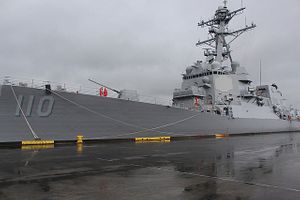On Tuesday, the United States Navy has staged its third freedom of navigation operation (FONOP) in the South China Sea since China started building artificial islands in the disputed Spratly chain. According to a senior U.S. defense official who spoke to the Wall Street Journal, the USS William P. Lawrence, an Arleigh Burke-class guided missile destroyer, sailed within 12 nautical miles of Fiery Cross Reef. In January 2016, the USS Curtis Wilbur sailed within 12 nautical miles of Triton Island in the Paracel Islands. In October 2015, the USS Lassen sailed within 12 nautical miles of several features in the Spratlys.
The Journal‘s report is sparse on details, but does note that the “destroyer took one pass past the island in an operation the defense official described as routine.” A single pass suggests that the USS William P. Lawrence likely complied with innocent passage, which is proscribed under Article 18 of the United Nations Convention on the Law of Sea (UNCLOS). Fiery Cross Reef, as it existed before China’s extensive island-building work, was mostly fully submerged at high tide, with the exception of two rocks. These two rocks may entitle the feature to a 12 nautical mile territorial sea, though China’s extensive land reclamation and dredging has transformed the feature into a large artificial island. (Artificial islands do not receive any special consideration.)
Tuesday’s operation near Fiery Cross Reef comes after reports in late-April suggested that the United States had canceled a scheduled FONOP to instead fly aircraft to demonstrate resolve at Scarborough Shoal, a feature disputed between China and the Philippines that Washington feared could be the next target of China’s land reclamation. Though the United States takes no position on the sovereignty of individual features in the South China Sea, its freedom of navigation program seeks to protest what it regards as excessive maritime claims under customary international law.
Fiery Cross Reef has been among one of the more discussed Chinese features in the Spratly Islands. It is among the group of seven features that China has chosen to turn into artificial islands. It has drawn particular scrutiny as the location of a 3,000 meter airstrip, which remains under construction. China has reclaimed 2,740,000 square meters* at Fiery Cross, according to the Center for Strategic and International Studies’ Asia Maritime Transparency Initiative. China has occupied the reef, which is also claimed by the Philippines, Taiwan, and Vietnam, since the late 1980s.
The choice of Fiery Cross also has particular signaling value for the United States, as Gordon Lubold notes in his report for the Journal. General Fan Changlong, vice chairman of the power Chinese Central Military Commission, visited Fiery Cross Reef recently, becoming the senior-most Chinese military official to visit one of China’s artificial islands in the South China Sea. Moreover, in a propaganda move, China recently sent popular military folk singer Song Zuying to perform for People’s Liberation Army-Navy and civilian construction personnel on Fiery Cross Reef.
Last year, senior Pentagon officials, including Secretary of Defense Ashton Carter, had said that the U.S. Navy would endeavor to increase the frequency of FONOPs in the South China Sea. 95 days passed between the Lassen and Curtis Wilbur operations; 101 days elapsed between the Curtis Wilbur‘s January operation and Tuesday’s operation near Fiery Cross Reef. The interval between operations has been roughly similar so far, suggesting that the Pentagon is sticking to its plan to keep up a drumbeat of operations in the South China Sea. At current rates, the next FONOP would likely take place in August 2016.
Fiery Cross Reef’s status under UNCLOS may be determined by a panel of judges reviewing the merits of the Philippines’ pending case at the Permanent Court of Arbitration in The Hague. The verdict in that case will likely be delivered next month.
*Corrected this number and unit.

































